Maxima/Minima Problems
- Use partial derivatives to locate critical points for a function of two variables.
- Apply a second derivative test to identify a critical point as a local maximum, local minimum, or saddle point for a function of two variables.
- Examine critical points and boundary points to find absolute maximum and minimum values for a function of two variables.
One of the most useful applications for derivatives of a function of one variable is the determination of maximum and/or minimum values. This application is also important for functions of two or more variables, but as we have seen in earlier sections of this chapter, the introduction of more independent variables leads to more possible outcomes for the calculations. The main ideas of finding critical points and using derivative tests are still valid, but new wrinkles appear when assessing the results.
Critical Points
For functions of a single variable, we defined critical points as the values of the function when the derivative equals zero or does not exist. For functions of two or more variables, the concept is essentially the same, except for the fact that we are now working with partial derivatives.
Definition
Let
be a function of two variables that is defined on an open set containing the point
The point
is called a critical point of a function of two variables
if one of the two following conditions holds:
-
- Either
does not exist.
Finding Critical Points
Find the critical points of each of the following functions:
-
-
- First, we calculate
Next, we set each of these expressions equal to zero:
Then, multiply each equation by its common denominator:
Therefore,
and
so
is a critical point of
We must also check for the possibility that the denominator of each partial derivative can equal zero, thus causing the partial derivative not to exist. Since the denominator is the same in each partial derivative, we need only do this once:
This equation represents a hyperbola. We should also note that the domain of
consists of points satisfying the inequality
Therefore, any points on the hyperbola are not only critical points, they are also on the boundary of the domain. To put the hyperbola in standard form, we use the method of completing the square:
Dividing both sides by
puts the equation in standard form:
Notice that point
is the center of the hyperbola.
- First, we calculate
Next, we set each of these expressions equal to zero, which gives a system of equations in
Subtracting the second equation from the first gives
Substituting this into the first equation gives
so
Therefore
is a critical point of
([link]). There are no points in
that make either partial derivative not exist.
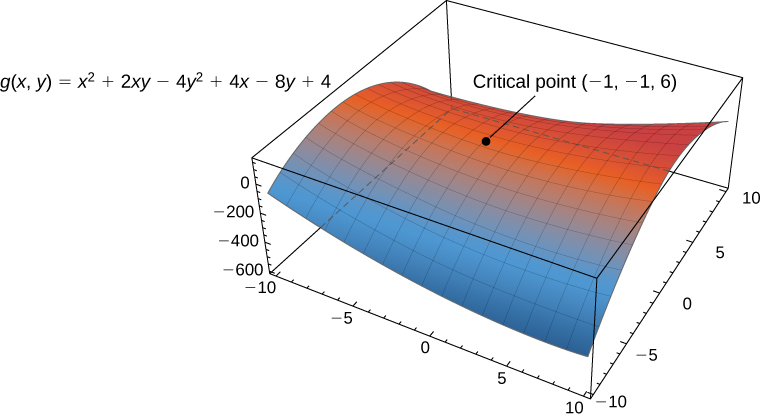
Find the critical point of the function
Hint
Calculate
and
then set them equal to zero.
The main purpose for determining critical points is to locate relative maxima and minima, as in single-variable calculus. When working with a function of one variable, the definition of a local extremum involves finding an interval around the critical point such that the function value is either greater than or less than all the other function values in that interval. When working with a function of two or more variables, we work with an open disk around the point.
Definition
Let
be a function of two variables that is defined and continuous on an open set containing the point
Then f has a local maximum at
if
for all points
within some disk centered at
The number
is called a local maximum value. If the preceding inequality holds for every point
in the domain of
then
has a global maximum (also called an absolute maximum) at
The function
has a local minimum at
if
for all points
within some disk centered at
The number
is called a local minimum value. If the preceding inequality holds for every point
in the domain of
then
has a global minimum (also called an absolute minimum) at
If
is either a local maximum or local minimum value, then it is called a local extremum (see the following figure).
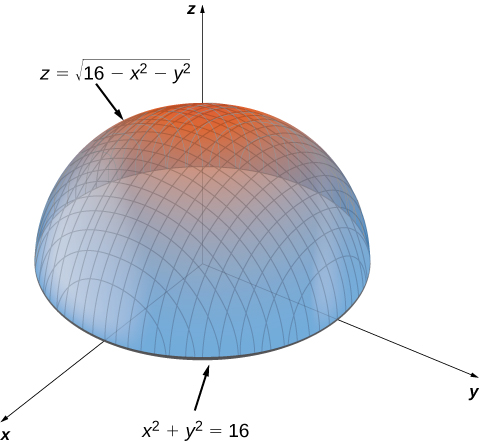
In Maxima and Minima, we showed that extrema of functions of one variable occur at critical points. The same is true for functions of more than one variable, as stated in the following theorem.
Fermat’s Theorem for Functions of Two Variables
Let
be a function of two variables that is defined and continuous on an open set containing the point
Suppose
and
each exists at
If
has a local extremum at
then
is a critical point of
Second Derivative Test
Consider the function
This function has a critical point at
since
However,
does not have an extreme value at
Therefore, the existence of a critical value at
does not guarantee a local extremum at
The same is true for a function of two or more variables. One way this can happen is at a saddle point. An example of a saddle point appears in the following figure.
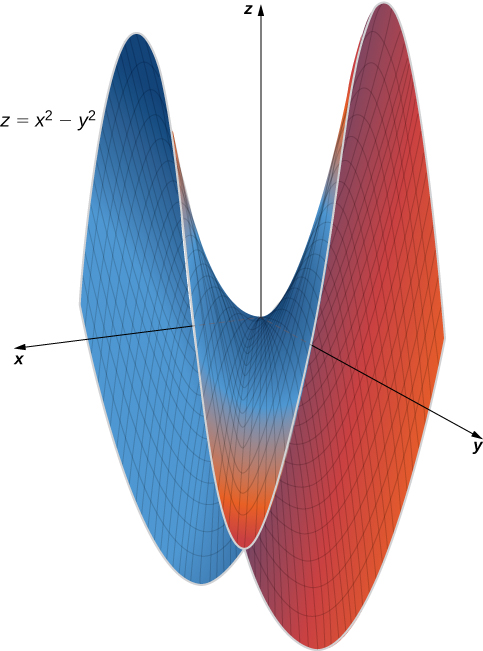
In this graph, the origin is a saddle point. This is because the first partial derivatives of
are both equal to zero at this point, but it is neither a maximum nor a minimum for the function. Furthermore the vertical trace corresponding to
is
(a parabola opening upward), but the vertical trace corresponding to
is
(a parabola opening downward). Therefore, it is both a global maximum for one trace and a global minimum for another.
Definition
Given the function
the point
is a saddle point if both
and
but
does not have a local extremum at
The second derivative test for a function of one variable provides a method for determining whether an extremum occurs at a critical point of a function. When extending this result to a function of two variables, an issue arises related to the fact that there are, in fact, four different second-order partial derivatives, although equality of mixed partials reduces this to three. The second derivative test for a function of two variables, stated in the following theorem, uses a discriminant
that replaces
in the second derivative test for a function of one variable.
Second Derivative Test
Let
be a function of two variables for which the first- and second-order partial derivatives are continuous on some disk containing the point
Suppose
and
Define the quantity
- If
and
then
has a local minimum at
- If
and
then
has a local maximum at
- If
then
has a saddle point at
- If
then the test is inconclusive.
See [link].
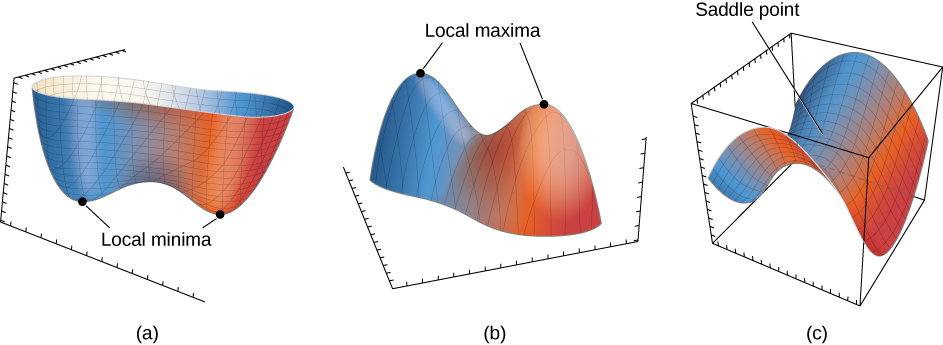
To apply the second derivative test, it is necessary that we first find the critical points of the function. There are several steps involved in the entire procedure, which are outlined in a problem-solving strategy.
Problem-Solving Strategy: Using the Second Derivative Test for Functions of Two Variables
Let
be a function of two variables for which the first- and second-order partial derivatives are continuous on some disk containing the point
To apply the second derivative test to find local extrema, use the following steps:
- Determine the critical points
of the function
where
Discard any points where at least one of the partial derivatives does not exist.
- Calculate the discriminant
for each critical point of
- Apply [link] to determine whether each critical point is a local maximum, local minimum, or saddle point, or whether the theorem is inconclusive.
Using the Second Derivative Test
Find the critical points for each of the following functions, and use the second derivative test to find the local extrema:
-
-
- Step
of the problem-solving strategy involves finding the critical points of
To do this, we first calculate
and
then set each of them equal to zero:
Setting them equal to zero yields the system of equations
The solution to this system is
and
Therefore
is a critical point of
Step 2 of the problem-solving strategy involves calculating
To do this, we first calculate the second partial derivatives of
Therefore,
Step 3 states to check [link]. Since
and
this corresponds to case 1. Therefore,
has a local minimum at
as shown in the following figure.
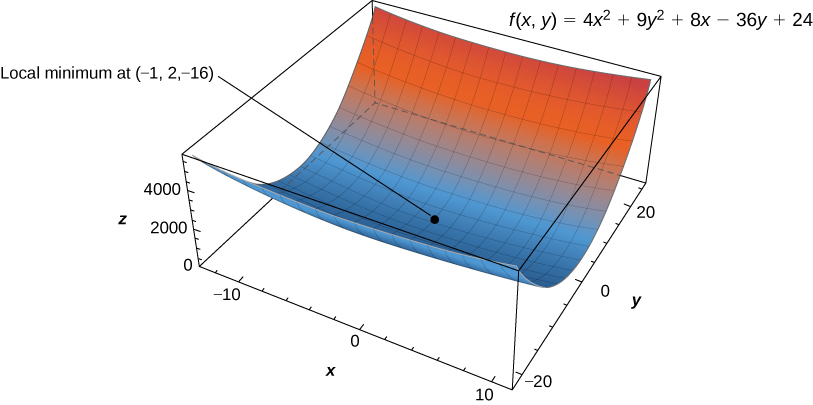
- For step 1, we first calculate
and
then set each of them equal to zero:
Setting them equal to zero yields the system of equations
To solve this system, first solve the second equation for y. This gives
Substituting this into the first equation gives
Therefore,
or
Substituting these values into the equation
yields the critical points
and
Step 2 involves calculating the second partial derivatives of
Then, we find a general formula for
Next, we substitute each critical point into this formula:
In step 3, we note that, applying [link] to point
leads to case
which means that
is a saddle point. Applying the theorem to point
leads to case 1, which means that
corresponds to a local minimum as shown in the following figure.
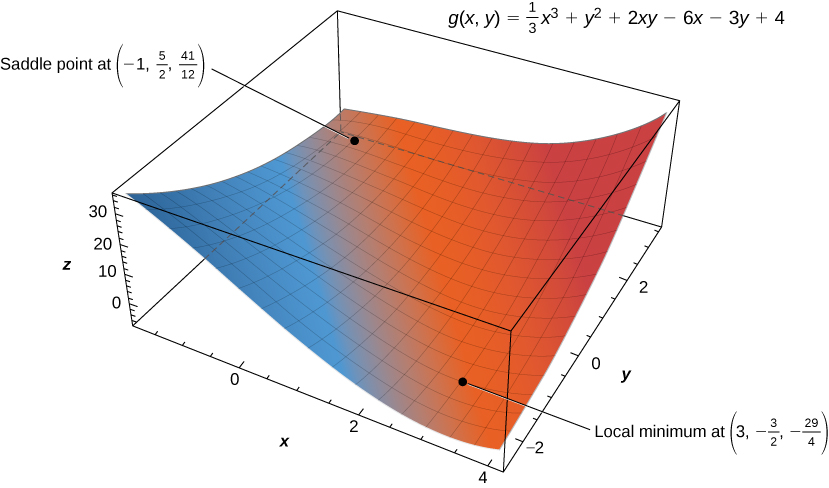
Use the second derivative to find the local extrema of the function
is a saddle point,
is a local maximum.
Hint
Follow the problem-solving strategy for applying the second derivative test.
Absolute Maxima and Minima
When finding global extrema of functions of one variable on a closed interval, we start by checking the critical values over that interval and then evaluate the function at the endpoints of the interval. When working with a function of two variables, the closed interval is replaced by a closed, bounded set. A set is bounded if all the points in that set can be contained within a ball (or disk) of finite radius. First, we need to find the critical points inside the set and calculate the corresponding critical values. Then, it is necessary to find the maximum and minimum value of the function on the boundary of the set. When we have all these values, the largest function value corresponds to the global maximum and the smallest function value corresponds to the absolute minimum. First, however, we need to be assured that such values exist. The following theorem does this.
Extreme Value Theorem
A continuous function
on a closed and bounded set
in the plane attains an absolute maximum value at some point of
and an absolute minimum value at some point of
Now that we know any continuous function
defined on a closed, bounded set attains its extreme values, we need to know how to find them.
Finding Extreme Values of a Function of Two Variables
Assume
is a differentiable function of two variables defined on a closed, bounded set
Then
will attain the absolute maximum value and the absolute minimum value, which are, respectively, the largest and smallest values found among the following:
- The values of
at the critical points of
in
- The values of
on the boundary of
The proof of this theorem is a direct consequence of the extreme value theorem and Fermat’s theorem. In particular, if either extremum is not located on the boundary of
then it is located at an interior point of
But an interior point
of
that’s an absolute extremum is also a local extremum; hence,
is a critical point of
by Fermat’s theorem. Therefore the only possible values for the global extrema of
on
are the extreme values of
on the interior or boundary of
Problem-Solving Strategy: Finding Absolute Maximum and Minimum Values
Let
be a continuous function of two variables defined on a closed, bounded set
and assume
is differentiable on
To find the absolute maximum and minimum values of
on
do the following:
- Determine the critical points of
in
- Calculate
at each of these critical points.
- Determine the maximum and minimum values of
on the boundary of its domain.
- The maximum and minimum values of
will occur at one of the values obtained in steps
Finding the maximum and minimum values of
on the boundary of
can be challenging. If the boundary is a rectangle or set of straight lines, then it is possible to parameterize the line segments and determine the maxima on each of these segments, as seen in [link]. The same approach can be used for other shapes such as circles and ellipses.
If the boundary of the set
is a more complicated curve defined by a function
for some constant
and the first-order partial derivatives of
exist, then the method of Lagrange multipliers can prove useful for determining the extrema of
on the boundary. The method of Lagrange multipliers is introduced in Lagrange Multipliers.
Finding Absolute Extrema
Use the problem-solving strategy for finding absolute extrema of a function to determine the absolute extrema of each of the following functions:
-
on the domain defined by
and
-
on the domain defined by
- Using the problem-solving strategy, step
involves finding the critical points of
on its domain. Therefore, we first calculate
and
then set them each equal to zero:
Setting them equal to zero yields the system of equations
The solution to this system is
and
Therefore
is a critical point of
Calculating
gives
The next step involves finding the extrema of
on the boundary of its domain. The boundary of its domain consists of four line segments as shown in the following graph:
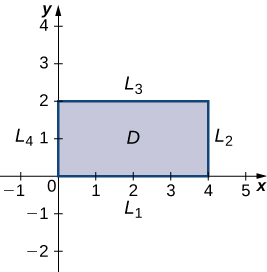
is the line segment connecting
and
and it can be parameterized by the equations
for
Define
This gives
Differentiating g leads to
Therefore,
has a critical value at
which corresponds to the point
Calculating
gives the z-value
is the line segment connecting
and
and it can be parameterized by the equations
for
Again, define
This gives
Then,
has a critical value at
which corresponds to the point
Calculating
gives the z-value
is the line segment connecting
and
and it can be parameterized by the equations
for
Again, define
This gives
The critical value
corresponds to the point
So, calculating
gives the z-value
is the line segment connecting
and
and it can be parameterized by the equations
for
This time,
and the critical value
correspond to the point
Calculating
gives the z-value
We also need to find the values of
at the corners of its domain. These corners are located at
The absolute maximum value is
which occurs at
and the global minimum value is
which occurs at both
and
as shown in the following figure.
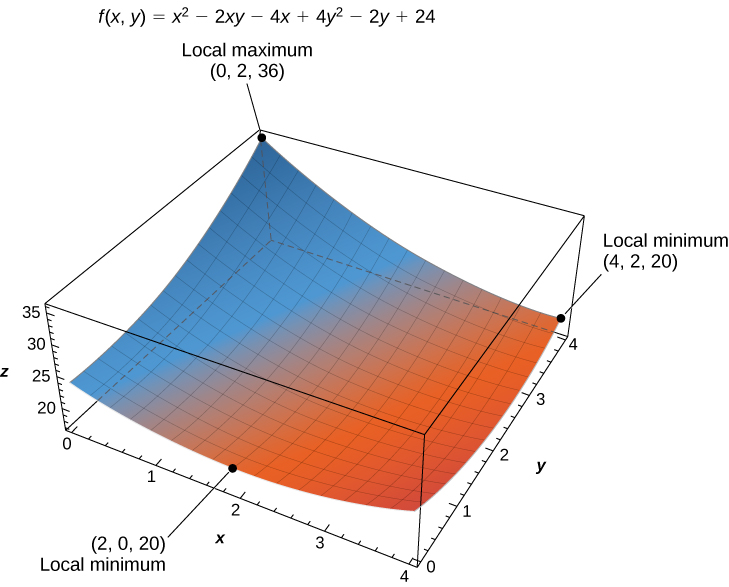
- Using the problem-solving strategy, step
involves finding the critical points of
on its domain. Therefore, we first calculate
and
then set them each equal to zero:
Setting them equal to zero yields the system of equations
The solution to this system is
and
Therefore,
is a critical point of
Calculating
we get
The next step involves finding the extrema of g on the boundary of its domain. The boundary of its domain consists of a circle of radius
centered at the origin as shown in the following graph.
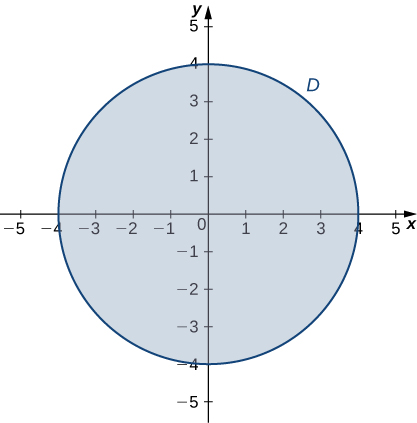
The boundary of the domain of
can be parameterized using the functions
for
Define
Setting
leads to
This equation has two solutions over the interval
One is
and the other is
For the first angle,
Therefore,
and
so
is a critical point on the boundary and
For the second angle,
Therefore,
and
so
is a critical point on the boundary and
The absolute minimum of g is
which is attained at the point
which is an interior point of D. The absolute maximum of g is approximately equal to 44.844, which is attained at the boundary point
These are the absolute extrema of g on D as shown in the following figure.
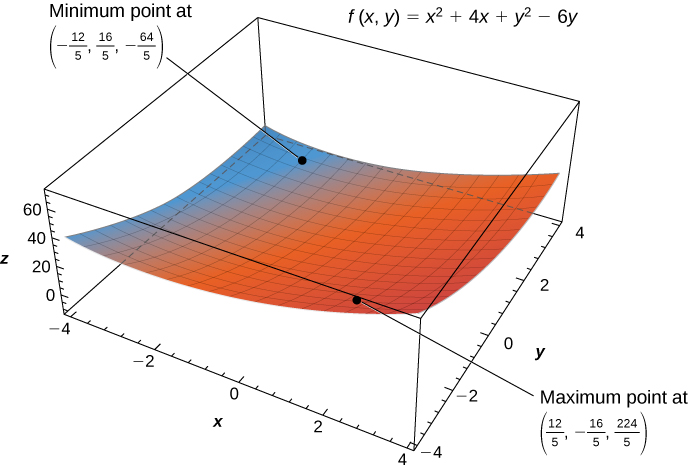
Use the problem-solving strategy for finding absolute extrema of a function to find the absolute extrema of the function
on the domain defined by
and
The absolute minimum occurs at
The absolute maximum occurs at
Hint
Calculate
and
and set them equal to zero. Then, calculate
for each critical point and find the extrema of
on the boundary of
Chapter Opener: Profitable Golf Balls

Pro-
company has developed a profit model that depends on the number x of golf balls sold per month (measured in thousands), and the number of hours per month of advertising y, according to the function
where
is measured in thousands of dollars. The maximum number of golf balls that can be produced and sold is
and the maximum number of hours of advertising that can be purchased is
Find the values of
and
that maximize profit, and find the maximum profit.
Using the problem-solving strategy, step
involves finding the critical points of
on its domain. Therefore, we first calculate
and
then set them each equal to zero:
Setting them equal to zero yields the system of equations
The solution to this system is
and
Therefore
is a critical point of
Calculating
gives
The domain of this function is
and
as shown in the following graph.
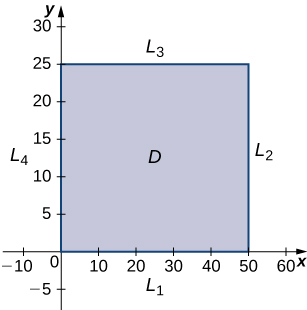
is the line segment connecting
and
and it can be parameterized by the equations
for
We then define
Setting
yields the critical point
which corresponds to the point
in the domain of
Calculating
gives
is the line segment connecting
and
and it can be parameterized by the equations
for
Once again, we define
This function has a critical point at
which corresponds to the point
This point is not in the domain of
is the line segment connecting
and it can be parameterized by the equations
for
We define
This function has a critical point at
which corresponds to the point
which is not in the domain.
is the line segment connecting
and it can be parameterized by the equations
for
We define
This function has a critical point at
which corresponds to the point
which is on the boundary of the domain. Calculating
gives
We also need to find the values of
at the corners of its domain. These corners are located at
The maximum critical value is
which occurs at
Therefore, a maximum profit of
is realized when
golf balls are sold and
hours of advertising are purchased per month as shown in the following figure.
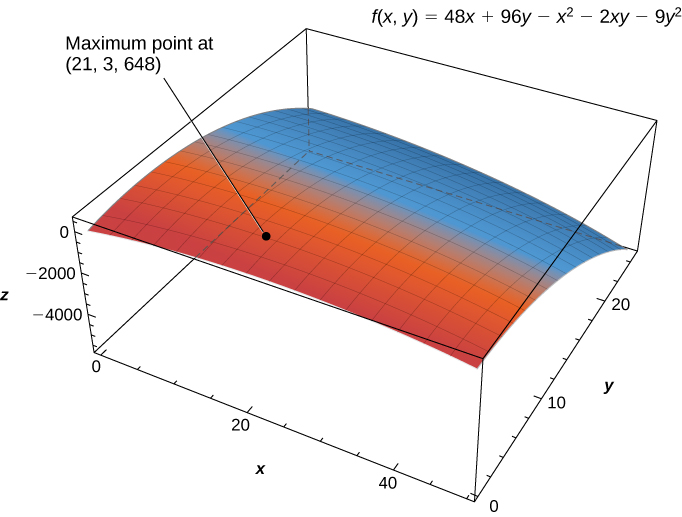
Key Concepts
Key Equations
- Discriminant
For the following exercises, find all critical points.
For the following exercises, find the critical points of the function by using algebraic techniques (completing the square) or by examining the form of the equation. Verify your results using the partial derivatives test.
Relative minimum at
For the following exercises, use the second derivative test to identify any critical points and determine whether each critical point is a maximum, minimum, saddle point, or none of these.
The second derivative test fails. Since
for all x and y different from zero, and
when either x or y equals zero (or both), then the absolute minimum occurs at
is a saddle point.
is a saddle point.
is a local maximum.
Relative minimum located at
is a saddle point.
and
are saddle points;
is a relative minimum.
is a relative maximum.
The relative maximum is at
is a saddle point and
is the relative minimum.
For the following exercises, determine the extreme values and the saddle points. Use a CAS to graph the function.
A saddle point is located at
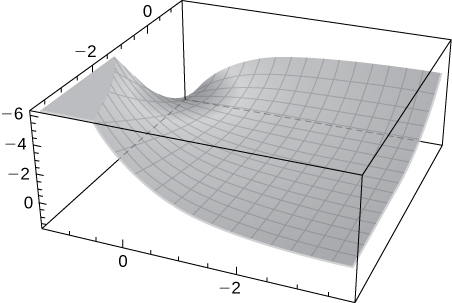
[T]
There is a saddle point at
local maxima at
and local minima at
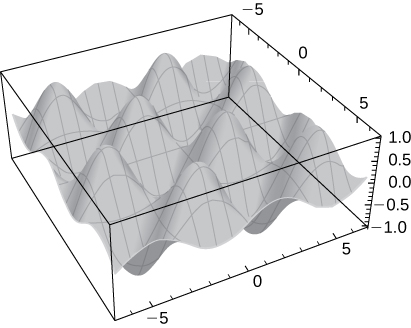
Find the absolute extrema of the given function on the indicated closed and bounded set
is the triangular region with vertices
Find the absolute maximum and minimum values of
on the region
is the absolute minimum and
is the absolute maximum.
on
on
There is an absolute minimum at
and an absolute maximum at
Find three positive numbers the sum of which is
such that the sum of their squares is as small as possible.
Find the points on the surface
that are closest to the origin.
Find the maximum volume of a rectangular box with three faces in the coordinate planes and a vertex in the first octant on the plane
The sum of the length and the girth (perimeter of a cross-section) of a package carried by a delivery service cannot exceed
in. Find the dimensions of the rectangular package of largest volume that can be sent.
A cardboard box without a lid is to be made with a volume of
ft3. Find the dimensions of the box that requires the least amount of cardboard.
Find the point on the surface
nearest the plane
Identify the point on the plane.
Find the point in the plane
that is closest to the origin.
A company manufactures two types of athletic shoes: jogging shoes and cross-trainers. The total revenue from
units of jogging shoes and
units of cross-trainers is given by
where
and
are in thousands of units. Find the values of x and y to maximize the total revenue.
A shipping company handles rectangular boxes provided the sum of the length, width, and height of the box does not exceed
in. Find the dimensions of the box that meets this condition and has the largest volume.
Find the maximum volume of a cylindrical soda can such that the sum of its height and circumference is
cm.
Glossary
- critical point of a function of two variables
- the point
is called a critical point of
if one of the two following conditions holds:
-
- At least one of
and
do not exist
- discriminant
- the discriminant of the function
is given by the formula
- saddle point
- given the function
the point
is a saddle point if both
and
but
does not have a local extremum at

This work is licensed under a Creative Commons Attribution 4.0 International License.
You can also download for free at http://cnx.org/contents/9a1df55a-b167-4736-b5ad-15d996704270@5.1
Attribution:















